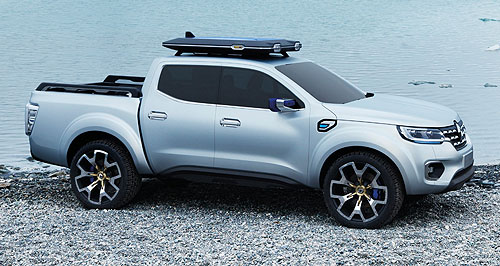Future models - Renault - AlaskanRenault pick-up won't be number oneComing soon: The Renault Alaskan concept was revealed in September last year, but the production version won't reach Australian shores until 2018. Nissan Navara-based Renault pick-up will target VW's Amarok, not Toyota HiLux6 Apr 2016 RENAULT Australia's chief says the company is not expecting its first one-tonne pick-up to challenge the Toyota HiLux and Ford Ranger for sales leadership, when it eventually arrives in Australia in 2018. The ute was previewed by the Alaskan concept in September last year and will be based on the same platform as Alliance partner Nissan's NP300 Navara, that went on sale in Australia mid-last year. The Alaskan name has not yet been officially locked in for the production version that is set to make its debut mid-year. As previously reported, about 95 per cent of the Alaskan concept design will carry over to the production model. Renault has already announced that the Alaskan-based pick-up will be built at plants in Argentina, Mexico and Spain, with South America likely to be the first region to get the new model. Speaking exclusively with GoAuto last week, Renault Australia managing director Justin Hocevar said the French brand is waiting for an announcement regarding production at the Alliance plant in Thailand alongside the Navara. “Obviously Navara is also sourced out of Thailand and it would be ideal to have the same sourcing and our business case is being built around that,” he said. “It is not locked in, not confirmed, but it's a probable outcome. “Australia is a key market for the rollout of this vehicle globally.” The timing for the global rollout means that it is unlikely to hit Australian showrooms until 2018, but Mr Hocevar said he believed that the Renault pick-up would beat the Mercedes-Benz ute – that is also based on the Navara underpinnings – to market. Mr Hocevar said he had realistic expectations for sales of the pick-up in Australia, given the fierce competition and massive volumes in the light-commercial ute segment. “I don’t necessarily think it is going to all of a sudden be a top player in the segment. What we hope to bring to our business, to our dealers, is a good volume opportunity in a very big, viable segment. I think what we are building now in our network is good capability on passenger car but good capability on commercial vehicles.” In the past two years the light-commercial pick-up segment has captured about 170,000 annual sales (4x2 and 4x4 combined) in Australia, making it second only in terms of volume to the small-car segment. Last year, the Toyota HiLux was the biggest seller in the sector, chalking up 35,161 sales to be the third most popular vehicle in the country, while Ford's Australian-developed Ranger took fifth spot with 29,185 sales. Other big sellers were Mitsubishi's Triton on 25,338 and the Holden Colorado on 18,520, while the Navara found 13,897 homes. Mr Hocevar highlighted the increasing trend of consumers buying a ute as their family car, and said Renault will have an advantage over its competitors thanks to its unique styling and the company's aftersales servicing packages. “They (utes) have also become a family car or lifestyle choice for many. Our strengths will be experience, robustness and capability from Alliance collaboration, but we also bring to it a design that has a unique appearance, relative to the others, which have converged to be very similar from this point of view. “I think that's a key point of difference. Another point of difference is that our peace of mind package differs. Warranties, capped-price servicing... we will focus heavily on those as well.” Mr Hovevar said Renault's proven history in building and selling light-commercial vehicles – its trio of vans have been the top-selling LCV range in Europe for the past 18 years – should give the car-maker a leg-up against its most obvious competitor when it launches here. “Who would be the more natural competitor in this market? It is obviously the Volkswagen Amarok. They probably came with even less inherent credibility in this segment than what we do. I'd like to think we have got a head-start in that regard.” The Amarok arrived in Australia in early 2011 and has built up sales consistently, shipping 8545 in 2015. While Renault Australia is yet to detail the line-up, Mr Hocevar said the company was “certainly exploring a couple of body styles and certainly exploring 4x2 and 4x4”, which suggests it could be offered in single- and dual-cab guise. He added that the line-up would not be as extensive as other ute rivals that have upwards of 30 variants. “I think it is about being focused on where the real opportunity is and making sure you have got a very compelling proposition there. It will be part of our strategy. We don't necessarily think we will be all things to everyone, but if we have got very solid proposals on a reduced range, that's a good starting point for us.”  Read more5th of April 2016  Exclusive: Koleos replacement imminentLarger Koleos replacement to give Renault a shot in the arm in mid-size SUV race5th of April 2016  Exclusive: New models to drive Renault growthRecent rapid sales growth unlikely to continue for Renault in Australia5th of April 2016  Exclusive: Seven-seat Renault Scenic on the cardsRenault Australia looking to fill seven-seat gap with fourth-generation Scenic16th of September 2015  Frankfurt show: Renault mulls Thai ute productionThailand still on the cards to supply Renault’s Alaskan ute for Australia |
Click to shareRenault modelsResearch Renault Motor industry news |






































Facebook Twitter Instagram